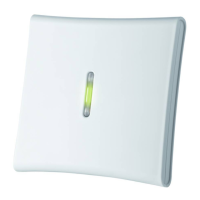2 D-302415 RP-600 PG2 Installation Instructions
3
33
3.
. .
. CONFIGURATION AND OPERATION
CONFIGURATION AND OPERATIONCONFIGURATION AND OPERATION
CONFIGURATION AND OPERATION
Service Messages
Five kinds of event codes are automatically included in a service
transmission in addition to the repeater’s:
•
AC fail
•
Low Battery
•
End of life
•
Tamper
• Supervision
.
Upon power failure, recharging stops and the backup battery takes over.
It is therefore correct to assume that without power input the battery is
gradually weakening and may be reported as “low”.
Power / battery restore is reported only in the following test report.
End of life is reported when battery power is depleted and device is
about to shut down.
Tamper restore is reported immediately upon occurrence.
If the tamper or power failure condition persists long enough,
respective alerts will be sent out again with each test report.
C
B
A
A. PowerG devices
B. RP-600 PG2 Repeater
C. Control Panel
Figure 3: Repeater Configuration
4
44
4.
. .
. MAINTENANCE
MAINTENANCEMAINTENANCE
MAINTENANCE
CAUTION!
Risk of explosion if battery is replaced by an incorrect type. Dispose of used battery according to manufacturer's instructions.
Note: Battery replacement should be done by a service man.
B
C
D
A
E
F
H
G
A. Turn & push battery
B. Battery pack connector
C. Connect the wires to the terminal block
D. Self-Test button
E. Enroll button
F. AC connector terminal block
G. Battery cable
H. Battery
Figure 4 - Battery Pack Insertion
5
55
5.
. .
. LOCAL DIAGNOSTICS TEST
LOCAL DIAGNOSTICS TESTLOCAL DIAGNOSTICS TEST
LOCAL DIAGNOSTICS TEST
Before testing, separate the base from the cover (see Fig. 2).
A. Press the self-test button once and release it:
The red LED and then the green LED will switch ON and then OFF in
turn to indicate that the repeater is now fully operational.
B. After 2 seconds the LED blinks 3 times.
The following table indicates received signal strength indication.
LED response Reception
Green LED blinks Strong
Orange LED blinks Good
Red LED blinks
Poor
No blinks No communication
IMPORTANT! Reliable reception must be assured. Therefore, "poor"
signal strength is not acceptable. If you receive a "poor" signal from
the device, re-locate it and re-test until a "good" or "strong" signal
strength is received.
1. For detailed Diagnostics Test instructions refer to the control panel
Installer Guide.
2. For UL/CUL installations, the test result must be “Strong”.

